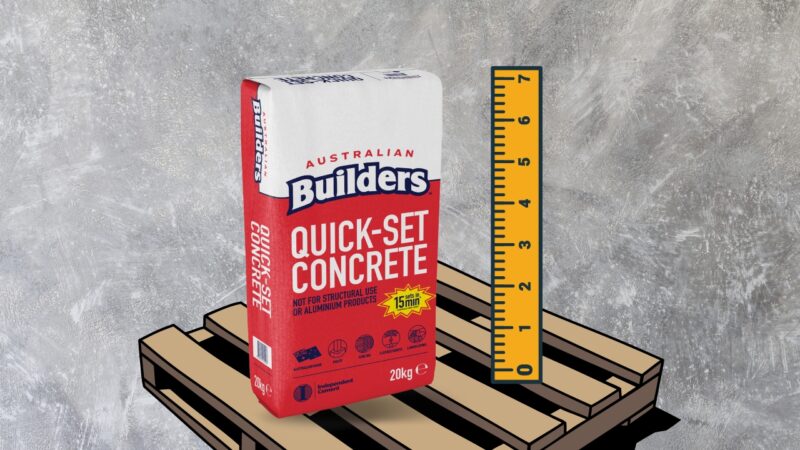As you embark on your next home improvement or construction project, understanding the finer details of your materials can be the difference between success and potential failure. One such material, a staple in most construction endeavors, is concrete. In the world of construction, the phrase “how many bags of concrete in a pallet” may seem straightforward, but there are numerous factors to consider, making it more intricate than you might expect. This blog post will explore everything you need to know about how many bags of concrete fit on a pallet, as well as the considerations that can affect this seemingly simple question.
Standard Bag Size and Weight: Key Factors to Consider

When dealing with concrete, the standard bag size and weight play a critical role. In the United States, concrete is commonly sold in bags of 60 or 80 pounds. Understanding the weight of each bag is crucial when calculating how many bags can fit on a pallet. It affects not only the total number of bags per pallet but also the feasibility of transportation and storage.
The size of the concrete bags is equally as important as their weight. Generally, an 80-pound bag of concrete mix will measure around 18 inches tall, 12 inches wide, and 4 inches deep. These dimensions may vary slightly based on the specific mix and manufacturer. Remember, the size of the bag can directly influence how many bags can be stacked on a pallet, so always consider this when planning your project.
Also, keep in mind that these standard sizes and weights may vary depending on the brand and the type of concrete mix. It is always best to check the product specifications before making any concrete purchase decisions. This way, you can accurately calculate the number of bags you’ll need and how many pallets will be required for transportation and storage.
Calculating the Number of Bags in a Concrete Pallet
Now, let’s talk about the number of bags on a pallet. A standard pallet in the US measures 48 inches by 40 inches. With the average bag size in mind, we can begin to calculate the number of bags per pallet. For 60-pound bags, a standard pallet can typically hold about 56 bags. However, 80-pound bags are larger and heavier, and a pallet will usually carry around 42 of these.
It’s important to note that these are averages and can vary based on the precise dimensions and packaging of the bags. Furthermore, while it’s possible to stack more bags on a pallet, safety is a priority. Overloading a pallet could lead to instability during transportation or storage, leading to accidents and product damage.
Therefore, when ordering concrete, keep in mind these averages for bagged concrete. You should also always verify the number of bags per pallet with your supplier. This will ensure accuracy in your calculations, as well as the safe and efficient transportation and storage of your concrete.
Pallet Size Variations

Though the standard pallet size in the United States is 48 inches by 40 inches, there are variations to this. Pallets can come in various other dimensions, depending on the needs of the industry or the specific requirements of a product. This can include pallets that are square-shaped or elongated, each with its own unique capacity.
Larger pallets, for instance, could hold more bags of concrete. However, the weight of the concrete bags and the load capacity of the pallet remain crucial considerations. It’s essential not to overload a pallet, irrespective of its size, to maintain safety during transportation and storage.
Always check the size of the pallets used by your supplier or manufacturer. This will not only give you a more accurate idea of how many bags of concrete can fit but also help you plan for transportation and storage. Ensure that the equipment and storage area you have can accommodate these pallets.
Understanding Different Concrete Mixes and Bag Requirements
There are numerous types of concrete mixes, each with different uses and requirements. From standard mixes for general construction to high-strength mixes for specific applications, the type of mix you choose can influence the number of bags you’ll need. Consequently, it can also affect the number of bags you can fit onto a pallet.
Different concrete mixes have different densities. High-density mixes, for example, are heavier and often come in smaller bags. This means that you could potentially fit more bags onto a pallet. However, remember that weight is also a significant factor here. Even if the bags are smaller, their increased weight may limit the number of bags you can safely put on a pallet.
Always consider the type of concrete mix when estimating the number of bags per pallet. If you’re uncertain, it’s a good idea to consult with your supplier or a construction professional. They can provide valuable advice tailored to your specific project.
Optimal Packaging
Optimal packaging plays a pivotal role in how many bags of concrete can fit on a pallet. Manufacturers often pack bags tightly together to maximize the use of space on a pallet. This not only allows more bags to be transported at once but also provides stability during transportation.
The pattern in which bags are placed on the pallet can also influence the number of bags it can hold. For example, bags stacked in an interlocking pattern often allow for more bags per layer, as this pattern utilizes the available space more efficiently.
However, the focus should not solely be on fitting as many bags as possible onto a pallet. It’s equally important to ensure that the pallet remains stable during transportation and storage. Overloading a pallet can risk it becoming unstable, potentially leading to accidents and damage to the bags of concrete.
The Role of Pallet Weight Capacity in Determining Bag Quantity

In determining how many bags of concrete a pallet can hold, it’s not just the size of the pallet and bags that matter. The pallet’s weight capacity is equally important. Pallets are designed to hold a certain maximum weight, and exceeding this limit can lead to problems, including potential damage to the pallet and a higher risk of accidents during transportation.
Most standard pallets can hold up to 4,600 pounds. Considering that an 80-pound bag of concrete is among the heaviest commonly used, a standard pallet could theoretically hold up to 57 of these bags. However, this does not consider factors like balance and safety, which may reduce the practical limit to around 42 bags.
Therefore, it’s essential to know the weight capacity of your pallets before you begin stacking concrete bags. Always make sure to stay within the safe weight limit to prevent any mishaps.
Special Considerations for Bulk Orders and Non-Standard Pallets
When dealing with bulk orders, different considerations come into play. In bulk purchases, concrete is often transported on larger, non-standard pallets, or even without pallets, directly loaded onto a truck. This can significantly alter the number of bags you’ll be dealing with.
Similarly, when dealing with non-standard pallets, their dimensions and weight capacity will dictate how many bags they can hold. These pallets may be larger or smaller than the standard size and might be designed to carry more or less weight.
In such situations, it’s especially crucial to liaise closely with your supplier to understand the specifics of your order. This will enable you to plan appropriately for transportation and storage.
Online Tools and Calculators
To simplify the process of calculating how many bags of concrete can fit on a pallet, there are several online tools and calculators available. These tools take into account factors like the size and weight of the concrete bags, the dimensions of the pallet, and the weight capacity of the pallet.
These calculators can be a great starting point for estimating your needs. However, remember that they provide estimates based on averages and standards. For accurate numbers, always consult with your concrete supplier.
In addition, some suppliers offer their own online tools and calculators tailored to their specific products. These can provide even more accurate estimates, particularly when dealing with non-standard bag sizes or specialized concrete mixes.
Tips for Properly Storing and Handling Concrete Pallets
Proper storage and handling of your concrete pallets are vital to ensure the integrity of the product. When storing, make sure the pallets are kept in a dry, covered area to prevent the bags from getting wet. Moisture can cause the concrete to harden prematurely.
It’s also important to handle the pallets carefully during transportation and storage. Always make sure the pallets are well-balanced and secure before moving them. This will help prevent accidents and damage to the concrete bags.
Additionally, avoid stacking the pallets too high. Overly tall stacks can be unstable and risk toppling over. Follow the manufacturer’s recommendations on the maximum safe height for stacking their pallets.
Final Words
Understanding how many bags of concrete fit on a pallet is essential for planning and executing any construction project. From estimating costs to organizing logistics, this seemingly simple detail can have a significant impact on your project.
While there are standards and averages to guide you, remember that every project is unique. Factors like the type of concrete mix, the size and weight capacity of your pallets, and the specifics of your order can all influence the number of bags per pallet.
By taking these factors into account, you can plan your project effectively and ensure a smooth construction process. Whether you’re a seasoned professional or a DIY enthusiast, a deep understanding of your materials will set you up for success in all your building endeavors.







